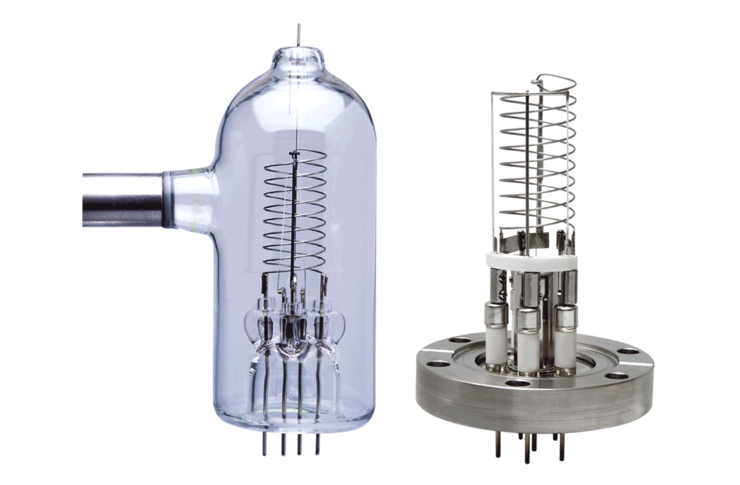BA601/BA602/BA603 Nude and Glass Hot Cathode

B-RAX™ 3300 and B-RAX™ 3400 operates the Ionization Gauges listed above.
FAQ
What is the principle of operation?
The hot cathode Bayard-Alpert ionization vacuum gauge operates by ionizing the gas inside the gauge and then measuring the number of ions generated. The ions are then collected giving a measurement of the density or pressure of the gas inside the transducer. The various electrodes used in the transducer design are a collector surrounded by a circular grid with one or two filaments outside the grid.
An electric current is passed through the filament to cause the filament temperature to increase. As the filament temperature is increased, electrons are emitted from the filament surface. The bias voltage between the filament and the grid will accelerate the electrons toward the grid. Most electrons will pass through the grid volume and exit the other side of the grid and then be drawn back into the grid for another traversal through the grid volume. Eventually, most electrons will impact the grid surface generating a current between the filament and the grid which is referred to as the emission current. The electronic controller is designed to maintain a constant, selectable emission current which is independent of pressure. While an electron is traversing inside the grid volume, it may collide with a gas molecule and ionize it which removes an electron. The ionized gas molecule, which now has a positive charge because it is missing an electron, will be attracted to the collector which is at ground potential. A current will be generated by the flow of ions to the collector which is known as the ion or collector current. An electrometer will measure the small ion current generated and a pressure, which is proportional to the ion current, can be calculated.
What is the measurement range of the BA600 series sensors?
- BA601: 2.00E-11 to 1.00E-03 Torr
- BA602: 2.00E-10 to 1.00E-03 Torr
- BA603: 2.00E-10 to 1.00E-03 Torr
Do the BA600 series sensors require an external controller to operate?
Yes. These are standalone sensors requiring a vacuum gauge controller to operate.
Which InstruTech controllers can operate the BA600 series sensors?
What are the available output signals from the BA600 series sensors?
The signal from the BA600 series sensors have to be processed by a vacuum gauge controller prior to providing an output signal. See your vacuum gauge controller specifications for the available outputs.
What is meant by the term “emission current”?
Emission current is the quantity of electrons emitted from the filament into the space inside the ion gauge transducer. The emission current can be changed to allow optimized operation of the ion gauge transducer at lower or higher vacuum. In general in higher pressure ranges of 5.00E-06 Torr to 5.00E-02 Torr, the 100 uA emission setting is preferred. At lower operating pressure ranges of 1.00E-08 Torr to 1.00E-04 Torr the 4 mA emission current setting should be used. For pressure below 1.00E-08 torr the 10 ma emission current should be used.
What filaments materials are available?
InstruTech offers two different filament materials.
- Yttria Coated Iridium
- Tungsten
Which filament material should I use?
For general vacuum applications, yttria coated iridium filaments are offered for use with inert gases such as air, Nitrogen, argon, etc. Tungsten filaments are available for use with gases that may not be compatible with yttria. The other tradeoff between the two filaments is that the tungsten filament will not survive accidental venting to atmosphere whereas yttria will. It is very important to make sure the tungsten filament is turned off before bringing the chamber up to atmosphere, especially if air is being used to vent the chamber.
How many filaments are there?
BA601 is offered with dual filaments. BA602 and BA603 are offered with both single or dual filament configurations.
What does degas mean?
Degas is used to rid the gauge sensor of adsorbed gas. Degas is achieved by applying Electron Bombardment (EB) to the grid. The sensor’s low pressure performance will normally improve after each degas cycle.
When can I apply degas?
Degas must be applied while the filament is turned on and operating. Ensure vacuum level is at or less than 5.00E-05 Torr before attempting to initiate degas.
Trademark Acknowledgements listed in the BA600 series Data sheets.